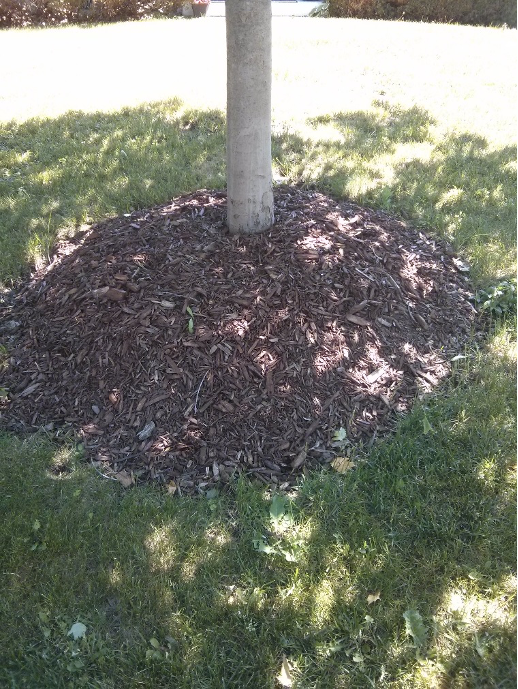Urban biodiversity: Mulching 101
By Patrick Hamel, June 19th 2020:
As many of us spend more time watching our yards grow greener, the temptation to mulch can become unbearable for the unsuspecting homeowner. Adding organic matter to the ground can help to provide nutrients to plants by breaking down over time, preventing weed growth, and retaining humidity. However, adding too much, especially in the shape of a mulch volcano, (thick layer of mulch or dirt laid around a tree and up against the trunk), is detrimental and likely to lead to the slow death of the tree.
Piling mulch (or dirt) against the tree decreases the oxygen available for the roots to grow. This leads to the production of upward-growing roots into the mulch. These are called girdling roots and can sometimes be seen as enlarged roots around the base of trees. Most often, they are hidden just below the surface. As they grow, they strangle the base of the tree, impeding the flow of nutrients and water. A sign of the presence of girdling roots is a tree base that is straight, or even narrower, where it touches the ground, instead of flaring out, and can swell above the girdling roots. Symptoms include small leaves, dieback of branches, poor growth, and abnormal openings in the canopy. It is possible to have an arborist remove these superficial roots; however, it is not always practical, and prevention by appropriate planting and mulching is key to tree health and longevity. Other causes of girdling roots include leaving ropes used to secure the root-ball at the nursery during planting, or planting too deeply or close to a paved surface.
Another consequence of mulch volcanoes is to create a moist environment in the bark, ideal for bacterial and fungal diseases and crown-rot development. Once the decaying bark under the mulch has died, the outer lifeline (cambium) of the tree is exposed, effectively discontinuing the supply of water and nutrients. Pathogens, including borer insects, thrive in humid conditions, accelerating the decline of the tree. Also, above-ground stems need to exchange oxygen and carbon dioxide freely. Mulch volcanoes impede these processes (in addition to making it harder for water to reach the roots), leading to tree-tissue stress and weakening.
Another risk of mulch volcanoes is harboring rodents. These are great habitats for these small animals, who may chew at the bark for food, leading to similar issues as discussed above.
Save yourself some time and money, and as a rule, do not apply more than 2 or 3 inches depth (2-in for poorly drained soil) of mulch around your tree, leaving at least an inch gap between the trunk and the mulch. Reapply only when most of the mulch has already decomposed. Remember that these problems do not occur overnight, but may take 3 to 5 years to appear, depending on the extent of the damage, and are very difficult to reverse. It is recommended to consult with an arborist for solutions to these issues.
Sources:
https://njaes.rutgers.edu/fs099/
https://hort.ifas.ufl.edu/woody/over-mulching.shtml
Example of over-mulching
Webmaster’s note: To a question about leaves as mulch, the author reminded us that “leaves or compost can be a good mulch option in moderation. A layer of compost (decomposed organic matter, as stated at the beginning of the article) or leaves is generally beneficial for the tree, as this is what is found in the forest. I’d just make sure it’s not too thick.

